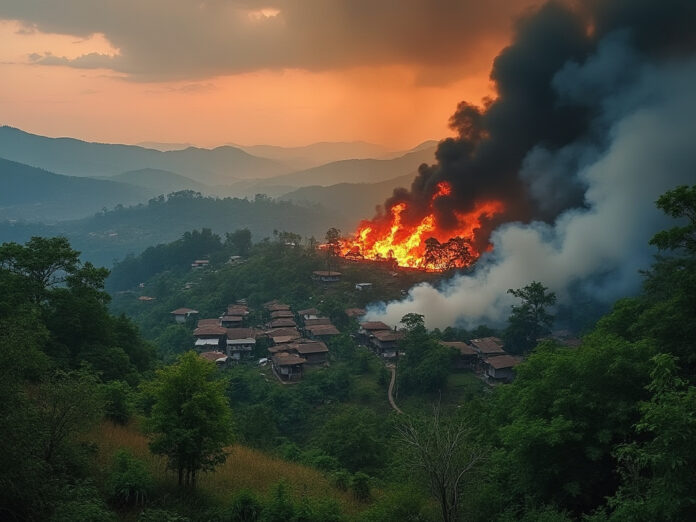India’s Inability to Govern Its Own Borders: The Northeast Crisis
India’s northeastern border, long neglected, remains a volatile region. Known as the “Seven Sisters,” these states have been plagued by internal conflict, mismanagement, and neglect. This environment has allowed militancy to thrive, while New Delhi’s efforts to govern have consistently failed. With rising instability in neighboring countries such as Myanmar and Bangladesh, India’s inability to manage unrest within its borders exposes a deeper issue. This mismanagement will have lasting consequences on India’s standing in the region and its ability to project power.
Instability in the Seven Sisters
The northeastern states of India—Assam, Nagaland, Tripura, Meghalaya, Manipur, Mizoram, and Arunachal Pradesh—remain isolated from the rest of the country. This isolation fosters a sense of alienation from the national government, leading to deep-rooted discontent. For decades, New Delhi has paid little attention to the region, allowing insurgent movements to take root.
Militant groups across the region challenge India’s authority, running parallel governments and collecting their own taxes. In Manipur, ethnic strife between the Meitei and Kuki communities has erupted into violence. New Delhi’s failure to address these tensions reveals its inability to govern the region effectively. As violence spreads into neighboring states, the entire northeast faces destabilization.
Myanmar Crisis and Its Spillover Effect
India’s problems in the northeast are worsened by Myanmar’s collapse. Rebel groups have seized territory along the India-Myanmar border, increasing instability in states like Manipur, where Kuki refugees have fled to escape the violence.
The influx of these refugees has heightened tensions between the Meitei and Kuki communities. The Manipur state government blames these migrants for criminal activities, further escalating the conflict. New Delhi has been reactive, failing to contain the violence or manage the refugee crisis. Myanmar’s collapse adds instability to a region already on the brink.
Bangladesh’s Political Shift and India’s Strategic Failures
Bangladesh’s political upheaval, marked by the fall of Sheikh Hasina and the rise of student movement, has further exposed India’s strategic shortcomings. For years, India’s foreign policy in the region relied heavily on Hasina’s government. With her ouster, India’s influence in Bangladesh has all but disappeared, and its reliance on a single political faction has proven to be a costly mistake.
Yunus is expected to adopt a more balanced foreign policy, strengthening ties with China and the United States, leaving India scrambling to maintain relevance. The political shift also threatens to worsen tensions along India’s northeastern border, where Bangladesh shares boundaries with several of the Seven Sisters. The rise of Islamist groups in Bangladesh could inflame tensions with India’s Muslim population, compounding internal challenges for New Delhi.
China’s Expanding Influence in South Asia
While India struggles, China steadily increases its foothold in South Asia, particularly in Bangladesh. Through its Belt and Road Initiative, China has made strategic investments in infrastructure projects, securing key positions in the region, including Bangladesh. The port at Cox’s Bazar is a clear example of China’s expanding presence, designed to strengthen its access to the Indian Ocean.
India has failed to counter China’s growing influence in the region. New Delhi’s inability to maintain a foothold in Bangladesh and the broader northeast demonstrates its weakening role as a regional power. As China’s presence in South Asia expands, India’s response remains poorly coordinated.
New Delhi’s Ongoing Governance Failures
The northeast crisis reflects India’s larger governance failures. For decades, New Delhi has viewed the region as peripheral, only addressing its issues when the situation spirals out of control. Insurgencies, ethnic conflicts, and border disputes have been neglected, allowing them to fester.
Instead of integrating the Seven Sisters into the national framework, New Delhi has permitted insurgencies to persist, relying on short-term solutions and reactive measures. This mismanagement leaves the northeastern states vulnerable to both internal conflict and external threats from neighboring countries.
Historical Issues in the Seven Sisters
India’s failure to govern its northeastern borderlands, known as the “Seven Sisters,” has led to widespread unrest and instability. The region has long suffered from ethnic conflict, poor governance, and neglect by New Delhi. As a result, militancy flourished, and the region remains turbulent. These conflicts are rooted in historical grievances and compounded by external influences from Myanmar and Bangladesh.
The Colonial Legacy of Neglect and Isolation
British colonial policies are the root cause of many problems in India’s northeastern states. The British annexed the region over a century, administering the hills as a frontier area with minimal integration into the central governance structures. This left the region disconnected from the rest of India. The British enforced the Inner Line Regulation of 1873, which restricted contact between hill tribes and plainspeople, deepening a sense of separation and alienation that persists today.
When India gained independence in 1947, the northeastern states were still isolated from the political, economic, and social development taking place in the rest of the country. This alienation continues to fuel resentment and discontent.
Ethnic Conflicts and Boundary Disputes
The Seven Sisters are home to over 150 indigenous communities, each with distinct languages and cultures. While this diversity is valuable, it has also led to significant ethnic conflicts. Colonial-era boundaries between states like Assam, Nagaland, and Manipur have caused long-standing disputes. The Nagas and Mao tribals in Manipur have clashed violently over land in the Dzukou Valley.
Territorial disputes have led to numerous violent clashes, further complicated by an influx of refugees and migrants from Myanmar and Bangladesh. The Indian government’s inability to resolve these conflicts has allowed them to spiral out of control.
Insurgency Movements and Political Violence
Insurgency took hold in the northeast shortly after India’s independence. The Nagas, under the leadership of Phizo, were the first to resist integration into India, declaring independence in 1947. This triggered decades of insurgency in Nagaland and spread to other northeastern states. Over the years, other communities, including the Mizos and Assamese, have also taken up arms to fight for autonomy, political recognition, and control of resources.
The government’s response has been a mix of military action and peace accords. While agreements like the Mizo Accord of 1986 temporarily quelled violence, many insurgencies persist. Groups like the United Liberation Front of Assam (ULFA) continue violent campaigns, destabilizing the region.
The Assam Agitation and Nellie Massacre
One of the most notable conflicts in the Seven Sisters is the Assam Agitation, which erupted in the late 1970s. This movement aimed to stop the influx of Bangladeshi migrants, seen as changing Assam’s demographic makeup. The agitation escalated into widespread violence, culminating in the Nellie Massacre of 1983, where over 3,000 people were killed.
The Indian government’s response to the Assam Agitation and Nellie Massacre was insufficient. While peace talks led to the Assam Accord, the underlying issues remain unresolved, fueling ethnic tensions in Assam.
External Influences from Myanmar and Bangladesh
Instability in Myanmar and Bangladesh worsens the situation in the northeastern states. Myanmar’s collapse has allowed rebel groups to seize territory along the India-Myanmar border, creating instability in Manipur and Nagaland. Refugees from Myanmar exacerbate tensions, leading to violent clashes.
Similarly, political turmoil in Bangladesh, with the ousting of Sheikh Hasina and the rise of Muhammad Yunus, complicates the situation. Instability in Bangladesh could spill over into northeastern India. Islamist groups gaining influence in Bangladesh pose a threat to India’s internal security, particularly in a region already fraught with religious tensions.
Decades of Neglect Fuel Instability
India’s northeastern region remains a battleground for ethnic conflicts, insurgency movements, and political violence. The historical neglect of the region, combined with the government’s failure to address the root causes of unrest, has left the Seven Sister States in a constant state of instability. The influence of external forces from Myanmar and Bangladesh only adds to the challenges India faces in governing the region effectively. The northeast serves as a stark example of New Delhi’s broader failure to manage its internal borders and project its power across its territory.
India’s Weakness Exposed
India’s inability to govern the Seven Sisters reveals a nation struggling to control its borders. The region’s internal instability, coupled with growing threats from Myanmar and Bangladesh, highlights New Delhi’s strategic failures. China’s increasing influence only deepens India’s challenges, further diminishing its role in the region. Without a coherent strategy to address both internal governance and external threats, India continues on a precarious path.

